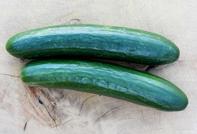Cucumber Cucumbers are produced commercially, in South Africa, in open land and in greenhouses.

Scientific name: Cucumis Sativus L
Common name: Cucumber
The general rule is that the large producers of cucumbers for processing are done in open fields and cucumbers for fresh consumption mostly in greenhouses, as this allows easier year-round production to ensure a continuous supply.
The cucumber is part of the family Cucurbitaceae, as are pumpkins, watermelon, cantaloupe and squash. Cucumbers are thought to have originated in Southern Asia and the Northern parts of Southeast Asia.
Cucumber Plant Description
The cucumber plant is a trailing vine that, without a trellis to climb, will cover a large area of ground. The plant has large hairy dark green leaves that are semi-triangular in shape. The plant is supported by a strong taproot that can grow to about one meter although most of the beneficial roots are in the top 30 cm of soil.
The plant produces both male and female yellow flowers. The male flowers appear first and then the female flowers. Female flowers have distinctive swollen ovary at the base of the flower, which later forms the cylindrical shaped fruit. About 10 male flowers will bloom for every female flower.
The two main types of cucumber produced are the regular cucumber, which produces stubby fruit of about 20 cm long and English cucumbers that grow to between 30 and 40 cm in length. The average diameter of cucumbers when ready for picking is about 4 to 5 cm.
Cucumber Uses
The English cucumber is mainly used for fresh consumption as a salad because of its very high water content and soft skin. The regular cucumber can be eaten fresh but has to be peeled because of its tough and slightly bitter skin.
The regular cucumber has slightly less water and is mostly used for processing. Cucumbers are also picked in their young or immature stage as baby vegetables. The cucumber is a diuretic and cleans the digestive system. It also breaks down uric acid and is said to be good for arthritis sufferers.
Soil Requirements and Preparation
The cucumber plant prefers well-drained sandy soils that have a high level of organic material. The pH of the soil should be between 6 and 7. Take soil samples and have them analysed. Plough and rip the top 500 mm of soil to incorporate the nutrients and organics required by the soil analysis and to ensure good root penetration and drainage.
Prepare the seedbeds at least 4 weeks before planting. This cleans the soil of weeds and old crop or weed residue. It is best to plant the seeds on slightly raised beds that have been covered with black plastic mulching.
Before covering the beds install the drip irrigation and make sure the soil is at the required pH and that pre-plant fertilizer has been worked into the top 20 cm of soil along the plant row with a disc harrow or cultivator.
Climate
Dry subtropical to slightly tropical climates are best for cucumber production. Soil temperatures above 15°C are required for good uniform seed germination. The best temperature for the production of flowers and fruit is between 20°C and 24°C.
Best vegetative growth occurs at between 26°C and 30°C. A good average for the growing season of cucumber would be between 22°C and 28°C. High humidity and regular rain is not good as this promotes the development of diseases.
Cultivars
There are hundreds of different varieties and colours of cucumber both natural and hybrids. The best course of action when deciding to produce cucumbers commercially is to grow what the market wants.
Also get expert advice from extension officers, horticultural advisors and seed specialists. Some commercial cucumber varieties are: Ashley, Beit Alpha, Carmen, Cohiba Delft, Long White, Marketmore, Muncher, National, Polaris, Sorolla, Straight Eight, Telegraph, Trimax and Zena.
By Louise Brodie